Archive for January, 2010
On the runway
I have changed my morning 6:45 session to the runway instead of the gym unless it is a really miserable weather day. There is a bike on base and I am biking 10km every morning which is 5.5 times round trip around the runway. Sometimes I will do it in the evenings as well.
It allows me to collect my thoughts and I start the crane and tractor up on my last lap so that they are warming up before we use them in ernest to launch boats at 8:45. Sometimes I will even move some of the boats into position in front of the labs so the beakers can just load up and we are in the water quicker.
Today there was a lone Emperor Penguin sitting on an iceberg off the north end of the runway. They are very rarely at Rothera only seen once or twice a year having got lost.
Comms on 18
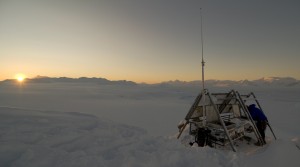
This picture was taken by Adam Clarke at the end of winter 2009 of the repeater on Reptile Ridge with the comms manager Webbo inspecting it.
All the support staff on base carry VHF radios as this is the only effective way of controlling operations and getting things done without having to walk around looking for people. Mostly the comms are used for runway and boating operations. We use Channel 18 and on top of Reptile Ridge is a repeater so there is a longer range. If you need to have a conversation that is longer than a few short transmissions we either switch to channel 6 if you are in line of site or to the phone system. People on SAR have to keep their radios on 24/7 just in case something happens that is not expected.
The standard procedure for boating ops is that we must keep in regular contact with ops (operations tower) throughout the operation. So we call when we are casting off with name of boat, destination, number of people and names of people on the boat and when we are calling next. We call in intervals of 30 minutes and or when we get to our destination and also when our trip is complete.
Back at the beginning of December the station ground to a halt for 30 minutes while the Argentines who have a base 40 or so km away called on 18 and wanted to have a chat with us about one of our planes that had buzzed over their base at 50 feet. When they called back on christmas day to wish us merry christmas they were swiftly told to go to HF radio.
More skua molesting!
The Skua chicks on the point have mostly all hatched now and the surveying continues. I went out with MVT last week and weighed the chicks and then measured their wingspans. Some of the parents are pretty docile and let you get on with it while protesting loadly. Others attack you so there is a need for hardhats and work gloves to fend them off. Nest number 3 is the worst and specialise in high speed passes where they wack you hard in the face with their feet. I was leaving their nest about 100 yards away when one of the parents got me hard it stung for quite a while and the impact was heard a ways away. This nest is in site of the tower so they get quite a lot of entertainment to pass the time.
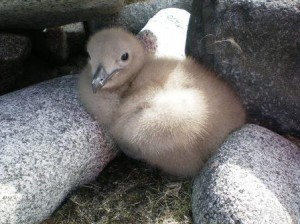
Adam at work
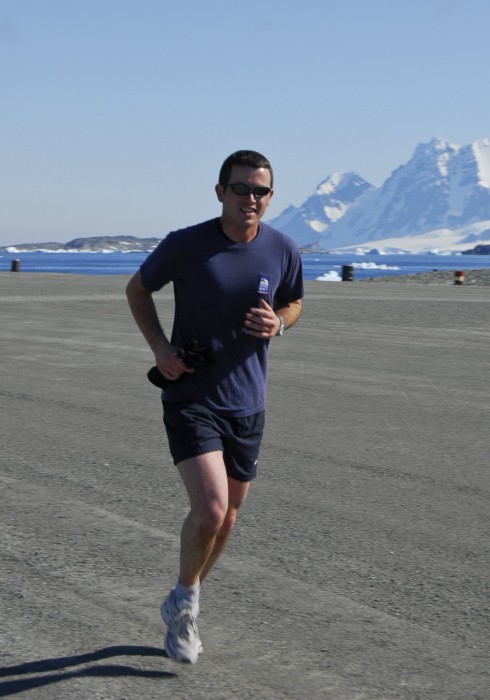
Adam Lane is a Navy pilot on loan to BAS and works in the comms department in the ops tower. After his 3 months down here he will be learning to fly helicopters. Down here he does flight following, SKEDS (with the field parties) and fire cover (when planes land).
Sunday Summit
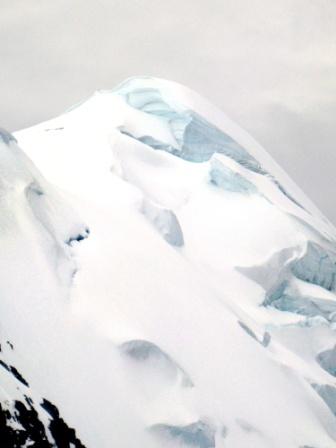 On Sunday Clive and I finally got good enough conditions to get over to Leonie to attempt the summit. We have been trying to get there since November. It requires the sea conditions to be good for a 9km boat ride to the island and then good enough summiting conditions and a forecast that is good to get a boat back out to collect us. Also it required Clive to be on base, not doing training and myself not on SAR. It all worked on Sunday however so we also took Alan (another Field Assistant) and Ian Dunn (BAS board member finance bod).
On Sunday Clive and I finally got good enough conditions to get over to Leonie to attempt the summit. We have been trying to get there since November. It requires the sea conditions to be good for a 9km boat ride to the island and then good enough summiting conditions and a forecast that is good to get a boat back out to collect us. Also it required Clive to be on base, not doing training and myself not on SAR. It all worked on Sunday however so we also took Alan (another Field Assistant) and Ian Dunn (BAS board member finance bod).
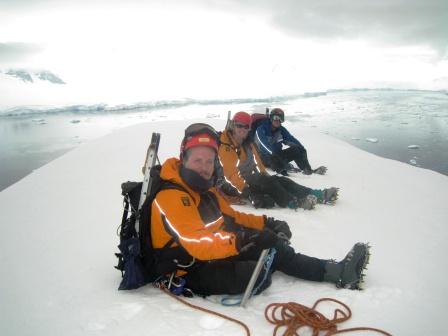
The station looked very small and insignificant from the top of Leonie. We were able to see whales (humpbacks) feeding from the summit and on the way back to base we had 30 minutes of watching them feed from 200 yards away on the boat.
It was a little bit technical crossing 5 crevasses that we could identify and many more which we didn’t see. We also had to use our ice axe and hammer at some points. There were some amazing cornices and bergshrunds with some large cliffs. All in all a great day followed by a movie and early to bed.
What a weekend!
Saturday morning the Laurence Gould came to alongside Rothera Wharf – they come in every year at the end of January. They disembarked 25 people on the basket system and loaded on 20 of us from the station for a science cruise out into Margerite Bay.
The Bonner Lab girls loved the water sampling and CTD setup onboard. This is Terri and Amber. Their CTD is calibrated every year in the US so ours is strapped onto their setup and they did 3 CTD sites on the cruise and then compare the readouts between them and ours allowing us to calibrate ours to their settings without sending ours off station.
We got a full tour of the vessel including the engine room and the bridge. I was allowed to drive the ship as well.
Although we were only 35km from base it felt good to get away and it felt like we got a proper weekend off with Sunday off as well.
After we got alongside at Rothera I went up the science mast on the ship and took some aerial photos.
After the mini cruise we did an oil spills exercise which was an envelope opened at the wharf and it was a ruptured tank on the ship spilling oil. Because the ship was at the wharf Danny and I launched off the beach at North Cove and came round to South Cove and then were tasked to install a boom around the ship and then deploy the skimmer inside the boom. It was quite a fun exercise in the sun.
We then had the annual Gould vs Rothera football match which was again won by BAS. After dinner it was time to party in the garage in the same style as New Years. I went to bed at midnight but the partying continued till 5am on Sunday morning. The Gould left Rothera at 7am.
So quite a busy Saturday here on base!
Arctic Terns
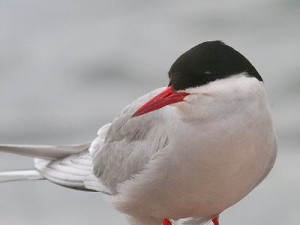
The terns are nesting on all the ridges at the moment so when we are ridge walking we have be careful not to tread on their nests. When we are out on the boat they swoop around us sometimes following us for a ways. The other day we watched one try to take on a Skua – everyone was routing for the little fella. They are very hard to get pictures of due to their speed of movement.
A few days ago BAS sent out a press release about a paper that confirms they have the longest animal migration in the world. New information on bird migration was revealed by an international team of scientists who confirmed that the Arctic tern flies more than 70,000 km on its annual migration trip from pole to pole — the equivalent of three trips to the moon and back over its lifetime. Scientists were able to map the migratory movements using the tiny tracking instrument known as a geolocator, which was developed by BAS scientists.
This simplified figure shows migration patterns of the Arctic tern, from the breeding sites in Greenland and Iceland to the winter grounds at Antarctica. After initiating the southbound migration (yellow line) the birds pause their migration in the central part of the North Atlantic (small circle) for almost a month before they continue towards the wintering sites at Antarctica (large circle). In spring, the northbound migration (white line) is conducted more than twice as fast in a gigantic ‘S’ shaped pattern through the Atlantic Ocean. Areas particularly rich in biological productivity are indicated by yellow and green colours.
I mentioned this in the dive boat and of course the marine biologists had lots of smart allack comments on how could a bird fly where there was no oxygen etc. but everyone did agree that it was a pretty amazing and hard to comprehend – those little birds have seen a lot!
Brittle Star – Ophionotus victoriae
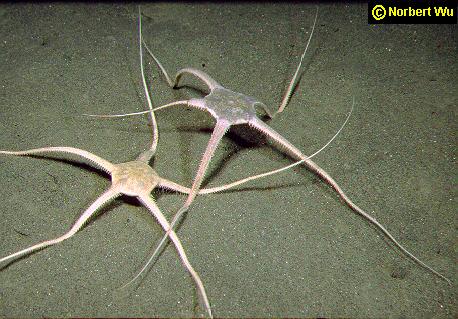
On a dive with Dave Barnes I measured the center disk of these little creatures with calipers in the IBIS grids. I have also collected quite a few of them for different projects. If one of their legs breaks off they can just grow another one. They hide really well in the sediment so you sometimes have to look closely to see an outline of them in the sand and then whaft away the sediment. They can also move pretty quickly and can be found at 5 to 1,266 meters which is a pretty large range. I think they look like little spaceships underwater!
For more information on this species of brittle star click here.
http://peterbrueggeman.com/nsf/fguide/echinodermata11.html
Boating Limits
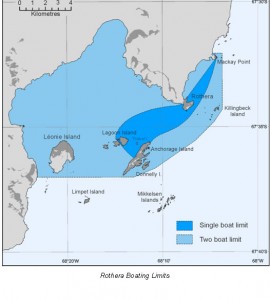
We have three RIBS at the moment two with twin engines and one with a single engine. The above chart shows the limits that we are allowed to go to away from base. It is quite a small geographical area however, conditions can change so quickly here and with the ice moving around continuously things could get out of hand even in the small distances we are looking at. This is why we have depots on Leonie, Anchorage and Lagoon as we might end up stuck out at the islands unable to make it back through the ice.
Saint David
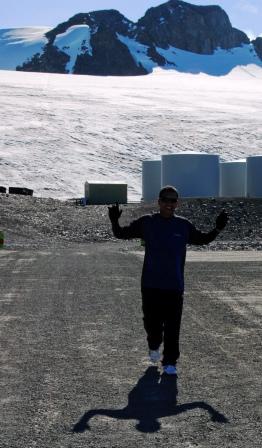
This is David he is from Saint Helena which is part of the British Overseas Territory and is an island in the south atlantic. Saint Helena measures about 16 by 8 kilometres (10 by 5 mi) and has a population of 4,255.
We have three Saints that come down for the summer season to act as station support staff. This is David’s first time down. They work a week of nights as night watch every three weeks. The night watch does two or three rounds of the station with numerous things to check including fridge temperatures, the aquarium in the bonner, generator sheds etc. There have been problems with the aquarium air conditioning so the marine assistant or biologist will be woken up by David if he is on watch. Also he wakes up me if I am on SAR and a plane comes in the middle of the night that requires cover.

